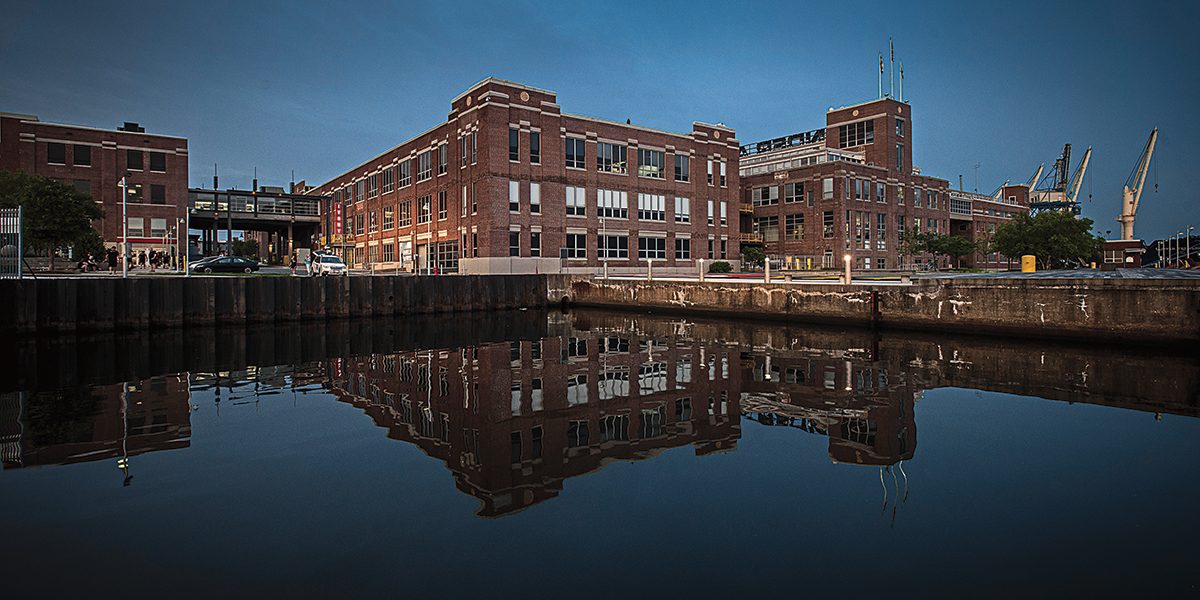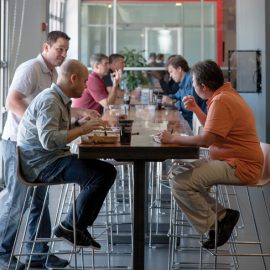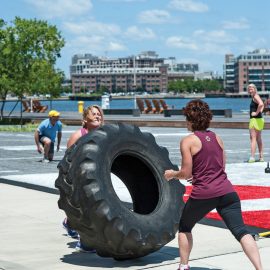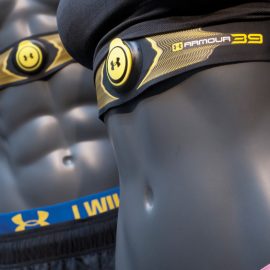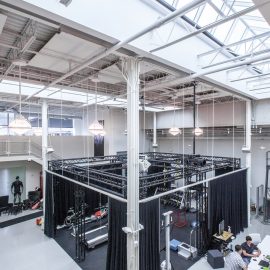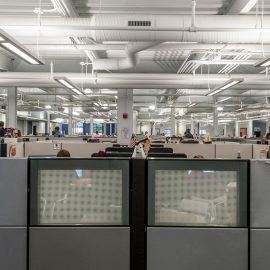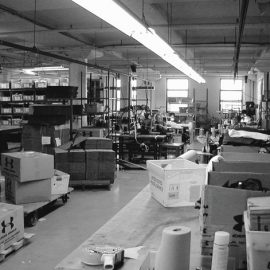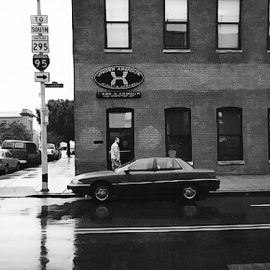News & Community
Shining Armour
An inside look at the behemoth athletic company and how it’s affecting Baltimore.
Nicole Doenges strolls onto the water taxi, sits on a plastic bench,
leans back, and watches the Canton shore fade from view. No blaring car
horns or wailing sirens pollute the air, no construction zones or red
lights impede progress.
The gentle hum of the boat’s motor, the reflection of bright sunshine
off the calmly lapping blue water, and the sound of seagulls calling
out as they glide through the sky are the soundtrack of her morning
commute.
This is rush hour?
“It’s a really relaxing way to get my day started,” says Doenges, 26,
who certainly looks anything but stressed. “I don’t even use my car
most of the week.”
She’s one of a half-dozen Under Armour employees aboard on this sunny
but brisk May morning. They’re all young, fit, and sporting at least
one item with the familiar interlocking UA logo that has become as
inescapable in Baltimore as Natty Bohs and Old Bay.
Like Microsoft in Seattle, FedEx in Memphis, and Ford in Detroit, Under Armour has become a part of its home city’s fabric.
The boat heads west toward Tide Point, where they used to make
detergent. Now, they spend their days making would-be athletes like you
and me better.
Some of the passengers hold travel coffee thermoses or their phones.
Most clutch both. Doenges, a graphic designer, has a yoga mat with her.
There’s a company-sponsored class after work, one of the many perks, she
says, that definitely elevate the job.
The Water Taxi, free to the public and paid for in part by her
employer, is another. Fifteen minutes after it leaves Canton Waterfront
Park, it reaches Locust Point. Doenges grabs her bag, smiles, and says,
“Thanks, Lar,” to Capt. Larry Pinker, and sets off up the gleaming metal
pier toward the campus where a company is transforming a city.
Or is it the other way around?
By now the microfiber-to-riches story of Kevin Plank
and Under Armour has become the stuff of business-school legend. In
1995, Plank, special teams captain for the University of Maryland
football team, noticed that the cotton T-shirts his teammates wore under
their jerseys constantly were drenched in sweat. Thinking there must be
a better way, he created a prototype that wicked moisture and kept the
athletes cool and dry. Working from his grandmother’s Washington, D.C.,
row house, Plank started the company he’s built into a
multi-billion-dollar behemoth.
Under Armour’s move to Baltimore was based partly on strategy, partly
on practicality, and partly on gut instinct. In 1999,the company signed
Georgia Tech as its first major client. It needed to leave grandma’s,
and fast. Plank, a Kensington native who, like so much of the non-Hon
speaking world, associated Baltimore primarily with the Orioles, Colts,
and the Inner Harbor, essentially was a free agent.
“We were getting pushed to places that people thought were suitable
for us, like out in Springfield, VA,” Plank says. “But my partner who
had just joined me, Kip Fulks [now COO], was a lacrosse player, and I
was thinking we should own lacrosse. Baltimore was a hotbed for that. I
had been here a few times when I was in school. The mayor [Governor
Martin O’Malley] was this energetic guy from D.C. There were a lot of
things that felt compelling.”
After meeting with a friendly landlord, Plank sealed the deal on his move to a 2,400-square-foot space on South Sharp Street.
“It was myself, Kip, a bookkeeper, and another person who answered
phones,” Plank recalls of those early years. “If we had someone
visiting, I’d hire my friends to come in and sit in chairs behind rented
computers and act like they were doing work.”
Enough got done that Under Armour quickly outgrew that space and
moved to a 15,000-square-foot facility on Bush Street in Pigtown. By
2003, the company was bursting at the seams and signed a deal to move to
the waterfront in Tide Point. Leaving the city, Plank says, was never
an option.
“When I looked at the factors, the culture and identity of Baltimore
is one of the things that attracted me as much as anything else,” he
says. “We wanted to build a hard-edged, blue-collar company, and that
attitude fit with what Baltimore was. We had a chip on our shoulder. I
think our city still does, and I think our company does.”
In the former Proctor & Gamble plant, Under Armour’s 25 or so
employees occupied about 20,000-square-feet. As the company continued to
grow, it gobbled up office space vacated by departing tenants. In 2011,
it bought the facility for a reported $58 million and almost
immediately mapped out an ambitious expansion plan. Today, 1,300 of its
employees occupy six buildings on the campus.
“We’ve seen every inch of this city,” Plank says. “Bush Street was
cool. The day we moved we threw a big block party with keg stands and
the whole nine yards. We played ‘Movin’ On Up’ from The Jeffersons. We
moved from across a scrap metal yard to the lap of luxury. We tell our
people that this campus should be the center of energy for our company
globally. We’ve stuck a flag in the ground here.”
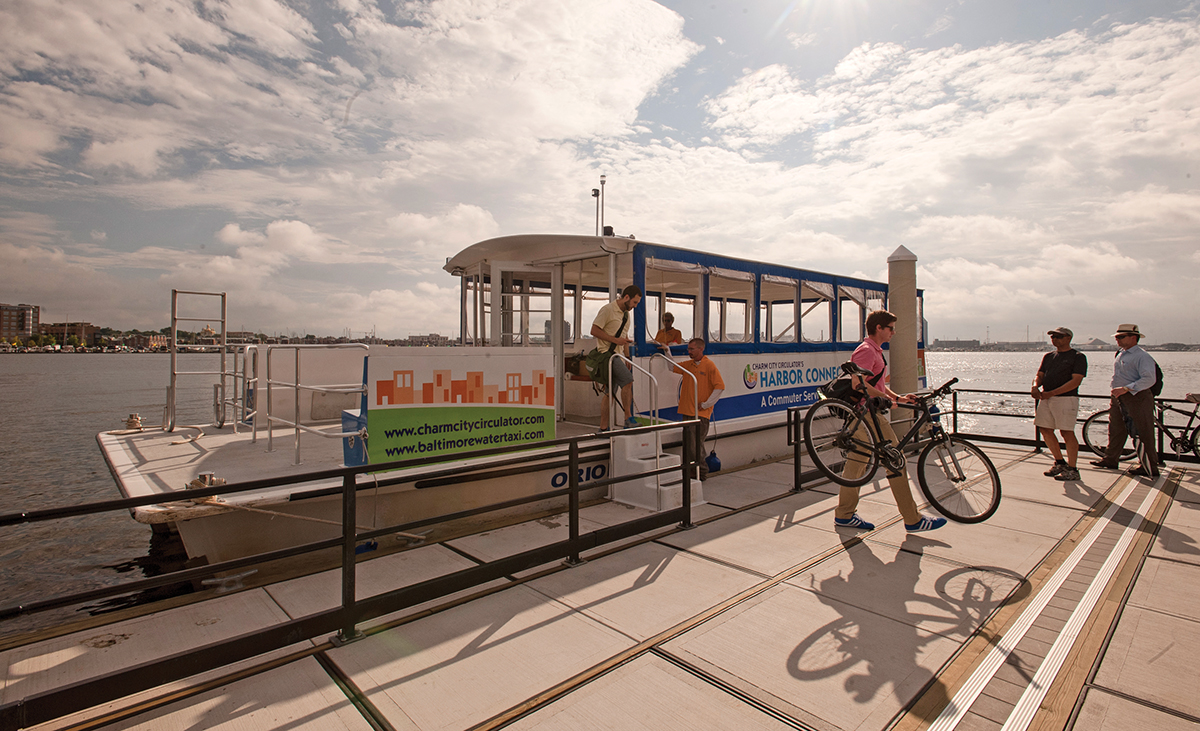
Larger-than-life photos of Under Armour athletes
greet visitors who pass through the front doors of the Ivory Building.
(Each building in Tide Point is named for a Proctor & Gamble
product.) The players—Kemba Walker (basketball), Bryce Harper
(baseball), Sloane Stephens (tennis)—are, perhaps like the company
itself, not yet superstars but hard-working young talents whose best
days are yet to come. In the third-floor lobby, three framed Baltimore
magazine stories proclaiming Under Armour one of the best places to work
in the city hang alongside copies of Plank’s business cards throughout
the years. In the early days, he carried both one that identified him as
the president of the company and one with the title “sales manager.”
Construction is underway on a freestanding visitors center in the middle of the 21-acre campus, but for now, guests report here.
“We thought Tide Point and this city fit our culture and our
company,” says Matt Mirchin, senior vice president of global brand and
sports marketing. “Blue-collar, inner-city tough. When people visit us
for the first time, they say they feel the energy. They say, ‘This is
how we envisioned Under Armour.’”
The workspace for many of the teammates, as Under Armour calls its
employees, is a maze of cubicles and seemingly never-ending racks of
clothing and shoes. There are several open spaces on most of the floors,
which have high ceilings and an industrial feel. Many people have
sports memorabilia surrounding their desks—a South Carolina football
helmet, a University of Utah jersey.
“We don’t have favorite teams,” Mirchin says. “If they’re not an Under Armour team, they don’t exist.”
As Plank’s alma mater and the company’s home state flagship school,
the University of Maryland is perhaps Under Armour’s most visible
client. (There’s a 55-yard replica of its football field on the Tide
Point campus.) In 2011, the company responded to the school’s request to
generate some excitement around the football program, redesigning the
team’s uniforms using the colorful state flag as inspiration. When the
primetime national television audience got its first glimpse during the
opening game, reaction was decidedly mixed.
“OH GOSH. Maryland uniforms. #Ewwwwww!” LeBron James declared on Twitter, where the uniforms were the top trending topic.
“We loved the fact that it generated such buzz,” Mirchin says. “Some
of it was negative, a lot of it was positive, but once you get that
conversation started, people can have their opinions. We loved it, we
thought it accomplished the goal.”
Under Armour employees don’t dress quite so flashy. They can wear
jeans, T-shirts, really anything they want (though you’d be hard-pressed
to find a Nike swoosh). Employees get a 50-percent discount on Under
Armour merchandise.
Each person who passes in the hall is somehow better looking than the
last, and most appear to be in top shape. When a new employee is hired,
they receive $50 a month toward a personal or group training session.
It’s up to the person whether or not to use the service, but a
commitment to physical fitness is strongly encouraged, if not expected.
The Under Armour Combine Training Center is a gym housed in the Tide
Building next door. It’s a state-of-the-art 10,000-square-foot facility
that is open to the general public and UA employees at a discounted
rate. It hosts group fitness classes and competitions, and generally is
packed in the early mornings and after work.
“We try to encourage an active lifestyle because it’s representative
of who we are as a brand,” Mirchin says. “You don’t necessarily need to
be an athlete to work here, but you need to know how to compete, and you
have to hate to lose.”
The campus essentially is divided by railroad tracks, on which
several freight trains pass through weekly. CSX sends an e-mail to
employees alerting them to a forthcoming train, which can take up to 45
minutes to chug by. Expansion plans call for a pedestrian overpass
(which will be 100 yards, the idea being for employees to sprint across
it) to connect the waterfront portion of the campus to the other side,
which houses the showrooms, cafeteria, and innovation lab.
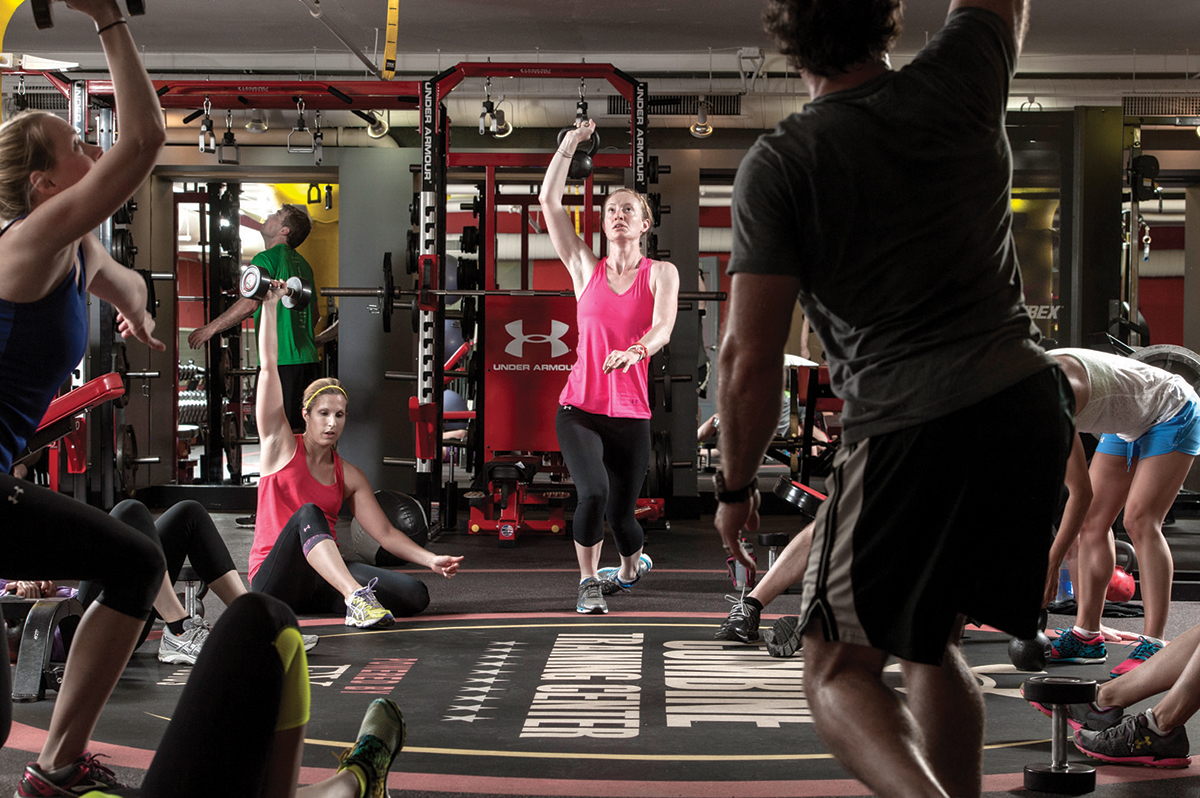
Considering all the exercising they do, it’s no
surprise that Under Armour employees crave calories. Many fuel up at the
Humble & Hungry Café, the company’s beloved eatery that serves
everything from sandwiches to sushi.
Each menu item is marked with a color-coded dot. Green denotes
healthy options, like a grilled salmon sandwich ($5.50) or a turkey
burger ($6, with one side). Yellow choices like the Philadelphia roll
($5) or bison burger ($7.50) are iffier, and red, plastered like a
scarlet letter next to items like mac and cheese and fries ($1 each),
are flat-out fattening.
“You can still have them if you’re having a bad day,” Mirchin jokes.
The large bay windows open when the weather is nice, and games
involving Under Armour teams are shown on the big screens. Coffee, tea,
and fountain sodas are free if employees use their own cups.
In another part of the Cheer Building, there’s a basketball court
that hosts pick-up games and tournaments. Hours had to be cut back when
the noise from hypercompetitive games got too disruptive.
Large showrooms allow the company snazzy venues in which to host
clients. Each one is dedicated to a specific market. For example, there
is quickly growing women’s apparel, which Mirchin says is 30 percent of
Under Armour’s business today but soon will be half, and Next, the
company’s name for its children’s line. Each showroom is
named—Dedication, Commitment, Inspiration, Vision, Pride.
“We try to brand everything,” Mirchin says. “People ask me all the
time what makes Under Armour different than our competitors, because
there are a lot of things we don’t have patents on. Anybody can buy the
same fabrics. It’s the people, it’s the culture, and it’s the brand.
When people buy Under Armour, they feel like it protects them and makes
them perform better.”
Much of what they’re purchasing is born in the adjacent innovation
lab. A top-secret facility to which only about 1 percent of the
company’s 6,000 worldwide employees have unfettered access, it’s headed
by Kevin Haley, an easy-going, deep-thinking former collegiate track
athlete and Under Armour’s first general counsel.
“Everything you could possibly want to do to a piece of fabric,
material, or textile, we do here,” says Haley, 44, senior vice president
of innovation. “It’s not enough just to make it look cool. We’ve got to
make sure it works.”
“Make All Athletes Better” declares a metal sign above the 007-like
entrance to the lab. A vascular scanner matches an employee’s ID badge
to the vein pattern on the back of their hand before the door
automatically opens.
Inside is a soaring, bright, multi-story open space, with work
stations on the second level. The lab contains technology ranging from
cutting edge—an environmental chamber that allows testing of apparel in
precise heat, cold, and humidity—to a boring, everyday washing machine.
Products must pass durability, abrasion resistance, and flexibility
tests before they are green lit. Haley occasionally refers to the lab as
the “proving grounds.”
“Sometimes you’ll get something to work, but then you’ve got to get
it through the washer and dryer,” he says. “It’s not too sexy, but it’s
one of the most challenging things we do.”
The company’s latest innovation is Armour39, a workout-monitoring
system that measures, tracks, and analyzes every move an athlete makes
though a module on a chest strap and an iPhone app. Today, engineer Mark
Oleson is testing it in the curtained-off variable-free workout center
on the lab floor.
Wearing shorts and a white Under Armour HeatGear Prototype shirt,
Oleson, 39, has been tracking his WILLpower, a single number calculated
using data collected from the device during a workout. After some
intense full-body exercise on the rowing machine, he does 30-pound curls
and 60-pound shoulder presses before declaring that he has the best job
in America.
“I’m getting paid to work out,” says Under Armour’s director of
product and innovation. He’s got the sweat to prove it. Aside from the
maddening “thinking outside the box,” “work hard and play hard” might be
the most overused, hokey cliché in all of business.
At Under Armour, it actually fits.
In between the yoga classes, basketball games, and cross-training,
Under Armour teammates are expected to complete exemplary work. A whole
lot of it.
“It’s definitely not a nine-to-five culture,” Mirchin says. “When
you’re growing at the rate we are, a lot of times people are doing more
than one job while you’re looking to hire more people. I would say
people here tend to stay later.”
That’s rubbed some former employees the wrong way. One person who
recently left the company after two years said they averaged 65- to
70-hour workweeks.
“We all drank the Kool-Aid,” the former employee says. “They promote a
work-life balance with the gym, the food, lots of fun activities. But
most nights I wouldn’t get home until 10, after my daughter was already
in bed. When you sign up for Under Armour, you know that they expect you
to put them first.”
Plank is very specific about the type of employee the company seeks to hire.
“You’re always looking for leadership,” he says. “I want people who
are going, ‘I was a lacrosse player and my fifth metatarsal was always
bothering me by the end of a game. How can I make a shoe that makes that
better?’ Everyone’s a salesperson for our company. The environment
we’ve created here, you’re treated like an adult, and we expect you to
bring a great attitude.”
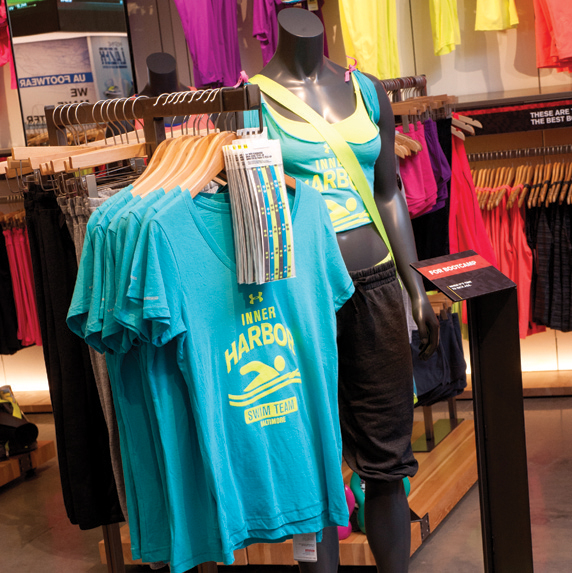
When Terry Hickey moved to Locust Point six years
ago, many of his neighbors weren’t even aware Under Armour was
headquartered in Tide Point. By 2011, however, the company was seeking
approval from the Locust Point Civic Association for its expansion plan
that included more office space, parking, and a retail outlet.
“From the beginning, Under Armour was very smart,” says Hickey, now
the civic association’s president. “They avoided the
we’ll-do-this-with-or-without-you approach. I was on the board when this
started, and I can tell you, support certainly wasn’t unanimous. There
were folks who were taken with Under Armour—its jobs, its prestige. On
the other hand, there were people who think any big company is bad. The
folks in the middle realized that we needed to work with them to get a
good outcome.”
The company committed more than $200,000 to the civic association for
improvements to Latrobe Park, an area rec center, and street-scaping
along Fort Avenue. In January 2012, more than 100 members of the
association unanimously voted to support the PUD (Planned Unit
Development) amendments and a separate agreement with Under Armour to
make its neighborhood investments.
Later that year, the city approved $35 million in Tax Increment
Financing for infrastructure upgrades in the area. It will potentially
issue bonds to pay for street and promenade improvements and new
athletic fields for the company and the public. The debt will be repaid
by property taxes generated by the company.
“They’ve done their best to be active community partners and work
with the neighborhood on issues,” said Baltimore City Councilman William
Cole, who represents the area. “It never hurts to have one of these
strong companies with ambitious plans wanting to expand in your city
because they’re bringing in a lot of people to work here. That helps
sustain our tax base.”
Under Armour funnels about $55 million into the state and city
coffers, based in part on its property taxes, taxes paid by its
employees, and tax revenue from its stores, according to a study by
Daraius Irani, executive director of the Regional Economic Studies
Institute at Towson University. That’s a significant figure for a
cash-strapped city. Add the company’s philanthropic exploits—its goal is
to spend $10 million over the next five years on athletic and academic
improvements to local schools (a new football field and 65 computers at
Dunbar High came first) as part of its WIN Baltimore initiative,
according to Mirchin—and it’s easy to see why its neighbors are willing
to stomach increased traffic or tight parking.
“They send somebody to pretty much every one of our monthly community
meetings,” Hickey says. “In that way, I think they’ve been a model.
When construction on the campus really starts in earnest, and if they
have plans to expand outside their campus in the future, there are going
to be some tough conversations and some people leveraged against it,
but I think they’re smartly building a relationship with the
neighborhood.”
Among the most contentious issues in Under Armour’s expansion
negotiations with the Locust Point Civic Association was its plan to
build a retail store on its campus. The company quickly shelved that
idea, deciding instead to open its “Brand House” in the Legg Mason
building in Harbor East.
“We’re a global company, and we’re opening offices all around the
world, but we are proud that Baltimore is our home,” says Henry
Stafford, senior vice president for apparel, outdoors, and accessories.
“We want people to know what we’re capable of, so we’re bringing our
best and brightest products to Baltimore.”
The 6,100-square-foot store has been open since February. Among its
most popular sellers are T-shirts that tap into Baltimoreans’ provincial
love for their neighborhoods. One features a UA logo smacked on the
side of a flamingo, above the word “Hampden.” In keeping with its flair
for the dramatic, there’s a four-sided JumboTron suspended from the
ceiling and a 750-pound carved wooden UA logo hanging on the back wall.
“Whether we open in Baltimore or New York City or Chicago or
Shanghai, we’re from there,” Stafford says. “There’s an element of that
hometown pride, that underdog, in every city. We’re the next great
brand, but we’re always going to be an underdog. We’re always going to
scrap and fight.”
Before it opened, more than 300 people interviewed for the initial 25
store associate positions that Under Armour calls “specialists.”
“I think all things aside, its impact is bigger than its numbers,
because it’s everywhere,” Irani says of the company. “The Under Armour
brand is becoming ubiquitous.”
In many ways, however, it’s still a piranha when compared to the
great white shark that is Nike. In April, Under Armour reported a
23-percent increase in first-quarter sales, to $472 million. Still, its
$2 billion in sales last year was less than one tenth of Nike’s,
according to Sports Illustrated.
“We know who they are, we know what they do, but we play our own
game, and we think we can continue to grow,” Mirchin says. “We just said
publicly that the next three years we’re going to double to $4 billion,
and, if you start worrying about what other people are doing, it’s very
difficult to achieve that.”
But Under Armour has certainly made its mark here. At night, a
reflection from the illuminated freestanding UA sign outside the Harbor
East store shimmers off the water. Light from the Under Armour complex
sign, as Tide Point now officially is known, shines from the other side
of the harbor.
Baltimore’s been branded a company town.
“The big, long-term vision is that some 22-year-old graduating from
college is going to say, ‘I applied to get a job at Under Armour,’”
Plank says. “‘I’ve got a [slim] shot, because it’s the greatest place in
the world to work, but regardless, I’m going to move to Baltimore,
Maryland, because it’s the coolest city in the world.'”
